![]()
![]()
![]()
Use LEFT and RIGHT arrow keys to navigate between flashcards;
Use UP and DOWN arrow keys to flip the card;
H to show hint;
A reads text to speech;
167 Cards in this Set
- Front
- Back
|
How are cells the fundamental unit of life? |
All organisms are made of cells Simplest collection of matter that can be alive Cells can differ substantially from one another, yet share common features robert |
|
|
Robert Hooke |
1666-first recorded microscope of fruiting bodies of mold |
|
|
Antoine van Leeuwenhoek |
1676- first person to record a Protozoa and bacteria He called them animalcules “Father of Bacteriology and protozoology” |
|
|
Microscopy |
Light microscope (LM) Visible light is passed through a specimen and then through glass lens Lens refract(bend) light so image is magnified The only one to allow observation of living things light microscope |
|
|
3 important parameters of microscopy |
Magnification Resolution Contrast |
|
|
Magnification |
The ratio of an objects image to its real size (1,000x LM) |
|
|
Resolution |
The measure of the clarity of the image or Minimum distance of two distinguishable points (200 nm LM) |
|
|
Contrast |
Visible difference in brightness between parts of a sample (improves by staining or labeling cell parts) |
|
|
Light microscopes |
Can magnify to 1,000 times the actual size of the specimen Various staining techniques enhance contrast Allow to see living things |
|
|
Phase-contrast |
2 rays of light are diffracted, direct and reflected Light in phase to black out of phase Internal structures sharply defined |
|
|
Differential interference |
Similar to phase contrast uses prisms split light beam adding contrast color 3 D |
|
|
Recent advances |
Labeling cells with fluorescent markers Confocal and deconvolution: provide sharper images of 3 dimensional tissues and cells Super resolution |
|
|
2 types of Electron microscopes (EM) |
Scanning electron microscopes (SEMs) Transmission electron microscopes (TEMs) |
|
|
Scanning electron microscopes ( SEMs) |
Focus a beam of electrons onto the surface of a specimen covered with a thin layer of gold Provides 3D image |
|
|
Transmission electron microscopes (TEMs) |
Focus a beam of electrons through a specimen Used mainly to study the internal structure of cells (heavy metals) |
|
|
Comparison of microscopes |
Three types: LM, TEM, SEM |
|
|
Cell fractionation |
Breaks cells apart and separated major organelles from one another by size Centrifuge (spins) leaves a pellet of cellular debris starting with nucleus. Can keep repeating this to get more separation to study organelles Different fractions will give you different organelles |
|
|
2 types of cells |
Prokaryotic Eukaryotic |
|
|
Prokaryotic |
Only organism: bacteria and archaea No nucleus No membranebound organelles DNA in unbound region called nucleoid (circular in shape) |
|
|
Eukaryotic |
Protists, fungi, animals, and plants DNA in nucleus bound by double membrane Membrane bound organelles Cytoplasm in region btw nucleus and plasma membrane Larger than prokaryotic cells |
|
|
Basic features of all cells: |
Plasma membrane-selective barrier Cytosol-semifluid substance Chromosomes-carry genes in DNA Ribosomes-make proteins based on instructions in genes
|
|
|
Plasma membrane |
Selective barrier that allows sufficient passage of oxygen, nutrients, and waste to service the volume of every cell For each micrometer of membrane, only a limited number of a substance can cross at a time so ratio of volume to surface area |
|
|
Metabolic requirements set upper limits on size of cells |
Surface area (SA) to volume (V) ratio are critical As a cell increases in size, its V increases faster than SA High SA is associated with high transport rates across the plasma membrane The need for a surface that can accommodate a lrg V is why cells are small (larger organisms do not have bigger cells, just more of them)
|
|
|
Nucleus |
5 (micrometers) Contains most of the DNA (some is in the chloroplasts and mitochondria) Contained by a nuclear enevelope Nuclear membrane is a double membrane Nuclear side of envelop is lined by nuclear lamina Pores regulate entry |
|
|
Nuclear envelope |
Enclosed the nucleus Separates it from the cytoplasm Is double membrane created by lipid bilateral Perforated by pore structures |
|
|
Nuclear membrane (double membrane) |
Consist of a lipid bilayer |
|
|
Nuclear lamina |
Composed of network of protein filaments Maintains shape of nucleus by mechanically supporting the the nuclear envelope |
|
|
Pore complex |
Regulate entry and exit of molecules from the nucleus (proteins, RNA, large complex macromolecules) |
|
|
Inside the nucleus |
DNA is organized into chromosomes Contains chromatin Nucleus directs DNA to rewrite genetic information as mRNA (transcription) |
|
|
Chromatin |
DNA and proteins of chromosomes in nucleus Condensed (coil) to form discrete chromosomes as cells divide |
|
|
Chromosomes in nucleus |
Each chromosome is composed of a single DNA molecule associated with proteins Human cell has 46 chromosomes, 23 sex chromosomes |
|
|
Nucleolus |
Located within nucleus Site of ribosomal RNA synthesis and assembly of the ribosomal subunits |
|
|
Nuclear pores |
Nuclear exit for ribosomal subunits with protein, mRNA |
|
|
Ribosomal RNA (rRNA) |
In nucleolus Synthesized and assembled with proteins from the cytoplasm Forms large and small ribosomal subunits Use info from DNA to make proteins via mRNA intermediate |
|
|
Endomembrane system |
Nuclear envelope, Endoplasmic reticulum, Golgi apparatus, Lysosomes, Vesicles, Vacuoles, Plasma membrane Carries out various task (protein synthesis, transport, metabolism and movement of lipids, and detoxification)
|
|
|
Vesicles |
Components are either continuous or connected via transfer ( sacs made of membrane) |
|
|
Endoplasmic reticulum (factory) |
Accounts for more than half of the total membrane in many eukaryotic cells The ER membrane is continuous with the nuclear envelope and has 2 distinct regions: smooth ER and rough ER |
|
|
Smooth ER |
Lacks ribosomes Synthesizes lipids, pops, phospholipids, and steroids (sex hormones and adrenal) Metabolizes carbs Detoxifies drugs and poisons (smooth ER in liver cells). Increase in smooth ER creates tolerance Stores calcium ions (muscle contraction, nerve impulse, calcium triggers protein secretion) |
|
|
Rough ER |
Surface is studded with ribosomes |
|
|
Rough ER |
Bound ribosomes Secrete glycoproteins Distributed transport vesicles Cellular membrane factory |
|
|
Cytosol |
A semi fluid, jellylike substance in which sub cellular components are suspended |
|
|
Lysosomes |
Membraneous sac of hydrolysis enzymes that many eukaryotic cells use to digest macromolecules Work best in acidic environments Carry out intracellular digestion |
|
|
Phagocytosis |
Engulfing smaller organisms or food particles The food vacuole formed by this then fuses with lysosome whose enzymes digest the food |
|
|
Autophagy |
Lysosomes help the to continually renew itself Hydrolysis enzymes to recycle the cells own organic material Damaged organelle or small amt of cytosol surrounded by membrane-lysosome fuses with it, dismantles membrane and material is released to the cytosol for reuse |
|
|
Vacuoles |
Large vesicles from ER and GA. Transport solutes. Solution inside a vacuole differs from compositions outside of it |
|
|
Food vacuoles |
Formed by phagocytosis |
|
|
Contractile vacuoles |
In fresh water eukaryotes Pump excess water out of cell Maintain a suitable concentrations of ions and molecules inside the cell |
|
|
Central vacuole |
Develops by the joining together of smaller vacuoles Contains cell sap Absorbs water allowing growth of cell |
|
|
Mitochondria |
Site of cellular respiration Found in nearly all eukaryotic cells Cells that move or contract have more mitochondria per volume |
|
|
Cellular respiration |
Process that uses oxygen to drive the generation of ATP by extracting energy from sugars, fats, and fuels |
|
|
Chloroplasts |
In plants and algae Sites of photosynthesis Converts solar energy to chemical energy |
|
|
Cytoplasm |
In eukaryotic cells: the region btw the nucleus and plasma membranes |
|
|
Endosymbiont theory |
Ancestor of eukaryotic cell engulfed a oxygen-using, nonphotsynthetic prokaryotic cell Eventually formed with its host cell becoming endosymbiont (a cell living within another cell) Merged into a single organism-a eukaryotic cell with mitochondrion |
|
|
Mitochondria vs chloroplasts |
1. Both have 2 membranes 2. Both contain ribosomes and DNA molecules 3. Autonomous organelles, grow and reproduce within cell |
|
|
Mitochondrion membranes |
2 Phospholipid bilayer with collection of proteins embedded Inner is smooth but outer is convoluted called cristae |
|
|
Ribosomes |
Complexes made up of ribosomal RNAs and proteins Carry out protein synthesis Not membrane bound, therefore are not organelles Build proteins in 2 cytoplasmic locals |
|
|
Free ribosomes |
Suspended in cytosol Most proteins made in free ribosomes function within the the cytosol iE: enzymes that catalyze the first steps of sugar breakdown |
|
|
Bound ribosomes |
Attached to the outside of the endoplasmic reticulum or nuclear envelope Make proteins that are destined for insertion in membranes for packaging or for export ie: cells in pancreas that secrete digestive enzymes |
|
|
Glycoproteins |
Secretory proteins with carbs bonded to them |
|
|
Transport vesicles |
Vesicles in transit from one part of the cell to another Secretory proteins depart from the ER wrapped and spectated from cytosol |
|
|
Golgi apparatus |
After leaving ER, many transport vesicles travel to here Warehouse for receiving, sorting, shipping Proteins are modified and stored and sent to other destinations |
|
|
2 sides of golgi stack |
Cis face: receiving. Usually located near ER and fusing with golgi membrane Trans face: shipping. Vesicles arhat pinch off |
|
|
Cisternal maturation model |
Cisternae of the golgi progress forward from cis to trans face, carrying and modifying their cargo |
|
|
Cytosol |
A semi fluid, jellylike substance in which sub cellular components are suspended |
|
|
Lysosomes |
Membraneous sac of hydrolysis enzymes that many eukaryotic cells use to digest macromolecules Work best in acidic environments Carry out intracellular digestion |
|
|
Phagocytosis |
Engulfing smaller organisms or food particles The food vacuole formed by this then fuses with lysosome whose enzymes digest the food |
|
|
Autophagy |
Lysosomes help the to continually renew itself Hydrolysis enzymes to recycle the cells own organic material Damaged organelle or small amt of cytosol surrounded by membrane-lysosome fuses with it, dismantles membrane and material is released to the cytosol for reuse |
|
|
Vacuoles |
Large vesicles from ER and GA. Transport solutes. Solution inside a vacuole differs from compositions outside of it |
|
|
Food vacuoles |
Formed by phagocytosis |
|
|
Contractile vacuoles |
In fresh water eukaryotes Pump excess water out of cell Maintain a suitable concentrations of ions and molecules inside the cell |
|
|
Golgi apparatus |

After leaving ER, many transport vesicles travel to here Warehouse for receiving, sorting, shipping Proteins are modified and stored and sent to other destinations |
|
|
2 sides of golgi stack |
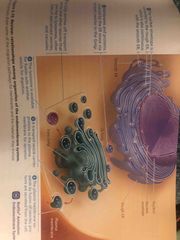
Cis face: receiving. Usually located near ER and fusing with golgi membrane Trans face: shipping. Vesicles arhat pinch off |
|
|
Cellular respiration |
Process that uses oxygen to drive the generation of ATP by extracting energy from sugars, fats, and fuels |
|
|
Chloroplasts |
In plants and algae Sites of photosynthesis Converts solar energy to chemical energy |
|
|
Phagocytosis |
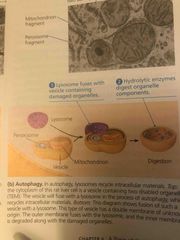
Engulfing smaller organisms or food particles The food vacuole formed by this then fuses with lysosome whose enzymes digest the food |
|
|
Endosymbiont theory |
Ancestor of eukaryotic cell engulfed a oxygen-using, nonphotsynthetic prokaryotic cell Eventually formed with its host cell becoming endosymbiont (a cell living within another cell) Merged into a single organism-a eukaryotic cell with mitochondrion |
|
|
Mitochondria vs chloroplasts |
1. Both have 2 membranes 2. Both contain ribosomes and DNA molecules 3. Autonomous organelles, grow and reproduce within cell |
|
|
Mitochondrion membranes |
2 Phospholipid bilayer with collection of proteins embedded Inner is smooth but outer is convoluted called cristae |
|
|
Ribosomes |
Complexes made up of ribosomal RNAs and proteins Carry out protein synthesis Not membrane bound, therefore are not organelles Build proteins in 2 cytoplasmic locals |
|
|
Free ribosomes |
Suspended in cytosol Most proteins made in free ribosomes function within the the cytosol iE: enzymes that catalyze the first steps of sugar breakdown |
|
|
Mitochondria |

Site of cellular respiration Found in nearly all eukaryotic cells Cells that move or contract have more mitochondria per volume |
|
|
Glycoproteins |
Secretory proteins with carbs bonded to them |
|
|
Transport vesicles |
Vesicles in transit from one part of the cell to another Secretory proteins depart from the ER wrapped and spectated from cytosol |
|
|
Endosymbiont theory |

Ancestor of eukaryotic cell engulfed a oxygen-using, nonphotsynthetic prokaryotic cell Eventually formed with its host cell becoming endosymbiont (a cell living within another cell) Merged into a single organism-a eukaryotic cell with mitochondrion |
|
|
2 sides of golgi stack |
Cis face: receiving. Usually located near ER and fusing with golgi membrane Trans face: shipping. Vesicles arhat pinch off |
|
|
Mitochondrion membranes |
2 membranes Phospholipid bilayer with collection of proteins embedded Inner is smooth but outer is convoluted called cristae |
|
|
Two parts of inner membrane of mitochondrion |
First: inter membrane space, narrow region btw inner and out membranes Second: mitochondrial matrix |
|
|
Peroxisome |
Specialized metabolic compartment bounded by a single membrane Contain enzymes that remove hydrogen atoms from various substrates and transfer them to O2 making hydrogen peroxide |
|
|
Functions of peroxisomes |
-Use oxygen to break down fatty acids to smaller molecules for transport to mitochondria for cell respiration -detoxify alcohol and other harmful compounds by transferring H to O
|
|
|
Glyoxysomes |
Specialized peroxisomes Found in fat-storing tissues of plant seeds Contain enzymes that convert fatty acids to sugar for seedlings to use until they produce their own |
|
|
Cytoskeleton |
Network of fibers extending throughout the cytoplasm 3 types of molecular structure: 1. Microtubles 2. Microfilaments 3. Intermediate filaments |
|
|
Support and motility of cytoskeleton |
Give mechanical support to cell and maintain shape Helps fix positions of organelles and enzymes Can be quickly dismantled in one part of cell and reassembled to change cell shape |
|
|
Cell motility |
Changes in cell location and movements of cell parts Requires interaction of the cytoskeleton with motor proteins ie: this is how vesicles containing NTs migrate along the axon |
|
|
Mitochondrial matrix |
Enclosed by inner membrane Contains different enzymes as well as DNA and ribosomes These enzymes catalyze cellular respiration-have large surface area due to folds of cristae-increases productivity of cellular respiration |
|
|
Chloroplasts |
Contains Green pigment chlorophyll, enzymes, and other molecules Separated from cytosol by 2 membranes |
|
|
Thylakoids |
Flattened interconnected sacs Membranous system |
|
|
Granum |
Stacked thylakoids ( looks like poker chips) |
|
|
Stroma |
Fluid outside the thylakoids Contains DNA, ribosomes, and enzymes |
|
|
Membranes of chloroplasts: 3 compartments |
1. Inter membrane space 2. Stroma space 3. Thlakoid space |
|
|
Plastids |
Plant organelles 2 types: amyloplast and chromoplast |
|
|
Amyloplast |
Plastid Colorless organelle that stores starch (amylose) |
|
|
Chromoplast |
Plastid Has pigments that give fruits and flowerss their yellow orange hues |
|
|
Two parts of inner membrane of mitochondrion |
First: inter membrane space, narrow region btw inner and out membranes Second: mitochondrial matrix |
|
|
Peroxisome |
Specialized metabolic compartment bounded by a single membrane Contain enzymes that remove hydrogen atoms from various substrates and transfer them to O2 making hydrogen peroxide |
|
|
Functions of peroxisomes |
-Use oxygen to break down fatty acids to smaller molecules for transport to mitochondria for cell respiration -detoxify alcohol and other harmful compounds by transferring H to O
|
|
|
Glyoxysomes |
Specialized peroxisomes Found in fat-storing tissues of plant seeds Contain enzymes that convert fatty acids to sugar for seedlings to use until they produce their own |
|
|
Cytoskeleton |
Network of fibers extending throughout the cytoplasm 3 types of molecular structure: 1. Microtubles 2. Microfilaments 3. Intermediate filaments |
|
|
Support and motility of cytoskeleton |
Give mechanical support to cell and maintain shape Helps fix positions of organelles and enzymes Can be quickly dismantled in one part of cell and reassembled to change cell shape |
|
|
Membranes of chloroplasts: 3 compartments |
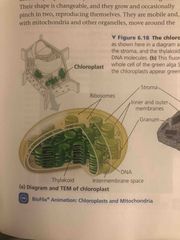
1. Inter membrane space 2. Stroma space 3. Thlakoid space |
|
|
Mitochondrial matrix |
Enclosed by inner membrane Contains different enzymes as well as DNA and ribosomes These enzymes catalyze cellular respiration-have large surface area due to folds of cristae-increases productivity of cellular respiration |
|
|
Chloroplasts |
Contains Green pigment chlorophyll, enzymes, and other molecules Separated from cytosol by 2 membranes |
|
|
Thylakoids |
Flattened interconnected sacs Membranous system |
|
|
Granum |
Stacked thylakoids ( looks like poker chips) |
|
|
Stroma |
Fluid outside the thylakoids Contains DNA, ribosomes, and enzymes |
|
|
Membranes of chloroplasts: 3 compartments |
1. Inter membrane space 2. Stroma space 3. Thlakoid space |
|
|
Plastids |
Plant organelles 2 types: amyloplast and chromoplast |
|
|
Amyloplast |
Plastid Colorless organelle that stores starch (amylose) |
|
|
Cell motility |
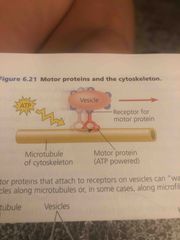
Changes in cell location and movements of cell parts Requires interaction of the cytoskeleton with motor proteins ie: this is how vesicles containing NTs migrate along the axon |
|
|
Microtubles |
Thickest of the 3 Hollowed rods constructed from tubulins Grow in length by adding tubulins and can be dissembled to build elsewhere in the cell Plus end can add tubulins at a much higher rate than the other end |
|
|
Dyneins |
large motor proteins that help with bending of cilia and flagella Attached to outer microtubule doublet Has 2 feet that walk along the microtubule using ATP for energy |
|
|
Microfilaments (actin filaments) |
Thinnest of 3, solid rods Built from molecules of actin Helps support cells shape which gives cortex a more solid like gel rather than liquid Role in cell motility |
|
|
Cortex |
Outer cytoplasmic layer of cell |
|
|
Myosin |
Made up of 1,000s of actin filaments and thicker filaments made of proteins Cause contractions of muscle cells |
|
|
Pseudopodia |
Cell crawls along surface by extending cellular extensions Brought by actin and myosin |
|
|
Cilia |
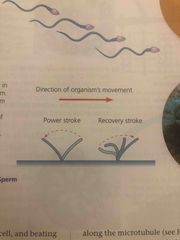
Microtubule containing extensions on a cell Usually cover cells surface Move like oars Act as antennas receiving signals for the cell Crucial to brain function and embryonic development |
|
|
Flagella |

Microtubule containing extension Usually one per cell Moves like a fish tail |
|
|
Tubulin Dimer |
A molecule made up of 2 components Make up a tubulin protein Consist of 2 slightly different polypeptides-alpha and beta |
|
|
Shapes and supports the cell, while also serving as a track along organelles to move motor proteins |
Microtubles |
|
|
Guide vesicles from ER to Golgi apparatus |
Microtubles |
|
|
Centrosome |
Where microtubules grow near the nucleus Compression resistant girders Exist a pair of centrioles |
|
|
Centrioles |
In the centrisome Composed of 9 triplet microtubules in a ring |
|
|
Cilia |
Microtubule containing extensions on a cell Usually cover cells surface Move like oars Act as antennas receiving signals for the cell Crucial to brain function and embryonic development |
|
|
Flagella |
Microtubule containing extension Usually one per cell Moves like a fish tail |
|
|
Common structure of cilia and flagella |
Has group of microtubules sheathed in an extension of plasma membrane 9 doublets arranged in a ring 9+2 pattern Anchored by a basal body |
|
|
Basal body |
Structurally Sinclair to a centriole Microtubule triplets in a 9+0 pattern Basal body of Soren enters egg |
|
|
Cell wall |
Distinguishes has Kant cells from animal cells Support the cell and keep out excessive water It’s very strong-cellulose Consist of primary, middle, and secondary |
|
|
Primary cell wall |
Primary cell wall: thin and flexible Middle lamella: this layer of sticky polysaccharides called pectins (like glue) Some plant cells secret a hardening substance into its primary wall while others add a secondary wall Second wall: several layers, strong and durable (wood) |
|
|
Extracellular matrix (ECM) |
Made up of glycoproteins and other carbs |
|
|
Collagen |
Most abundant glycoprotein in animal cells Strong fibers outside the cells Accounts for 40% of protein in human body Collagen fibers are embedded in a woven network made of proteoglycans |
|
|
Proteoglycans |
Secreted by cells P. Molecule consists of small core of proteins with carb chain through covalent bonds Large P. Complexes can form when hundreds of P. Molecules become noncovantly attached to a single long polysaccharide molecule |
|
|
Fibronectin |
Some cells are attached to the ECM by these glycoproteins Binds to cell surface receptor proteins (integrins) |
|
|
Integrins |
Receptor proteins on cell surface in plasma membrane Bind to microfilaments of the cytoskeleton on the cytoplasmic side Transmit signals as to what is happening inside and outside the cell |
|
|
Cell wall |
Distinguishes has Kant cells from animal cells Support the cell and keep out excessive water It’s very strong-cellulose Consist of primary, middle, and secondary |
|
|
Desmosomes |
Anchoring junction Fastens cells together Intermediate filaments made of keratin Attach muscle cells together. When there is a tear, damage to these cells |
|
|
Gap junctions |
Most like plasmodesmata in plants Communicating junction Cytoplasmic channels for communication, surround pore through which molecules pass through |
|
|
Primary cell wall |
Primary cell wall: thin and flexible Middle lamella: this layer of sticky polysaccharides called pectins (like glue) Some plant cells secret a hardening substance into its primary wall while others add a secondary wall Second wall: several layers, strong and durable (wood) |
|
|
Extracellular matrix (ECM) |
Made up of glycoproteins and other carbs Can influence activities of genes in the nucleus and orient cells of an embryo by matching the fibers of ECM |
|
|
Collagen |
Most abundant glycoprotein in animal cells Strong fibers outside the cells Accounts for 40% of protein in human body Collagen fibers are embedded in a woven network made of proteoglycans |
|
|
Proteoglycans |
Secreted by cells P. Molecule consists of small core of proteins with carb chain through covalent bonds Large P. Complexes can form when hundreds of P. Molecules become noncovantly attached to a single long polysaccharide molecule |
|
|
Fibronectin |
Some cells are attached to the ECM by these glycoproteins Binds to cell surface receptor proteins (integrins) |
|
|
Cell junctions in animal cells |
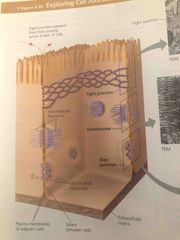
Especially common in epithelial tissue (lines external and internal surface of body) Tight Desmosomes Gap |
|
|
Plasmodesmata |
In plant cells Perforate cell walls Channels that connect cell walls |
|
|
Cell junctions in animal cells |
Especially common in epithelial tissue (lines external and internal surface of body) Tight Desmosomes Gap |
|
|
Tight junction |
Plasma membranes of neighboring cells are tightly pressed together bound by specific proteins Prevents leakage |
|
|
What is only in eukaryotic cells? |
Mitochondria |
|
|
Which molecules are more likely to diffuse across the membrane? |
Hydrocarbons like CO2 and O2 |
|
|
What is least likely to diffuse across the membrane? |
A large polar molecule |
|
|
If the internal solute in a plant cell is .8 M, what would it need to be outside the cell in order to produce plasmolysis? |
A higher molar solution |
|
|
Chromosome are always present in a cell? |
Yes, they may become more compact but are always present |
|
|
Synthesizes molecules in cells.. |
Ribosomes, rough ER and smooth ER |
|
|
All membrane proteins of the endomembrane systems are made in |
The rough ER |
|
|
Of five membranes, which is likely to be different? |
The mitochondrial outer membrane Not part of the endomembrane system Must synthesize their own proteins |
|
|
Chloroplasts and mitochondria.. |
Synthesize their own proteins bc they have DNA and ribosomes |
|
|
Microtubules guide vesicles from... |
The ER to the Golgi to the the plasma membrane |
|
|
What is found in animal cells but not in plant cells? |
Centrioles |
|
|
Cilia and flagella move due to the interaction of the cytoskeleton and |
Motor proteins such as dynein |
|
|
Plasmodesmata |
Cell wall contains numerous channels with strands of cytoplasm passing through them Connecting one cells cytoplasm to that of an adjacent cell |

